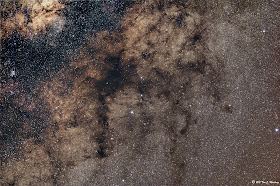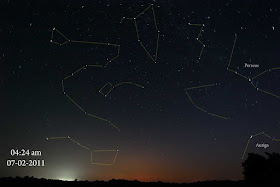Click on the image for a larger view
The image above is known as "The Wizard Nebula" in the constellation Cepheus. I don't see a wizard. Maybe you have better luck at seeing one. It could be that it looks like a wizard when seen visually through a telescope, but I kinda doubt it, because it's pretty faint. The camera picks up a lot more faint nebulosity than our human eyes can ever hope to do. Instead of a wizard, my mind does see a one-eyed black goblin. It's at the lower right of the image. Of course, this is just a dark, dusty region out in space. I can not find an offical name for the "dark nebula", but the Wizard is called Sh2-142, from a 1959 second version of a catalog by Stewart Sharpless. The star cluster involved with this nebula is NGC7380, from Dreyer's New General Catalog of 7,840 objects.The image was shot with my 190mm f/5.3 Maksutov/Newtonian. I took 12 10-minute shots for a total of 2 hours worth of data.
Click on the image for a large view
The deep sky object at the center of this image is the "Cave Nebula", officially known as Sh2-155, is also in the constellation Cepheus. Presumably the dark nebula on the right side of the bright nebula reminds one of the opening to a cave. I, however, see it as the head of a fire breathing dragon with it's body extending to the right. Do you see the red flames coming out of its mouth? Or maybe it's a cloud of bats. What do you think?The image was shot with my 300mm f/4 Canon lens, and my Q453 CCD camera. I took nine 20-minute shots for a total of 3 hours worth of data.
Click on the image for a larger view
I have annotated some of the other deep sky objects in the field and I have outlined the dragon.Click on the image for a large view
Double, double toil and trouble;
Fire burn, and cauldron bubble.
Fire burn, and cauldron bubble.
William Shakespeare
Shakespeare would have loved this image of the "Witch Head Nebula". There is no trouble seeing this Halloween character. She seems to be contemplating the bright light at the upper right, which is actually Rigel, the bright blue supergiant star in the constellation Orion. The Witch Head, lying in the Eridanus constellation, is a supernova remnant, the left over pieces of a star explosion. Dust particles in the cloud reflect the blue light from Rigel. The whole area is composed of molecular hydrogen and can be seen as the reddish areas surrounding the Witch Head.
The image was shot with my 300mm f/4 Canon lens, and my Q453 CCD camera. I took eight 20-minute shots for a total of 2 hours and 40 minutes worth of data.







































